Concordia Venus – The Goddess of Love brings Team Play to Concordia

Concordia is one of my favorite Euro games. It’s described on Board Game Geek as “a peaceful strategy game of economic development in Roman times.” Thus far, there’s been one large expansion – Concordia: Salsa – and several map expansions for Concordia. I have all of them. So, of course, Concordia Venus was at the top of my list of new acquisitions.

Concordia Venus is being released as both a stand-alone Concordia game and as an expansion for those who already own Concordia. The stand-alone Concordia Venus includes the Imperium map from the original Concordia base game, the new Venus components including the Hellas and Ionium maps, and a new Cyprus map. The Concordia: Venus Expansion has only the new Venus components and Hellas and Ionium maps. The Cyprus map is supposed to be released later in 2019 in another expansion. I don’t know if it’ll just be a map expansion or combined with something else.

What’s New
Let’s look in more detail at what’s new in Concordia Venus, other than the new maps, starting with the fancy description on the back of the box:
Concordia Venus: With the help of Venus, the goddess of love and intimacy, two partners work together at a game of Concordia while competing against one or two other teams. Mutual understanding and coordinated planning are essential to succeed as a harmonious couple.
Venus also offers a challenging new game variant for 2 to 5 individual players. With additional game material for a sixth player and new game boards, Concordia Venus can be integrated with the base game and all previous Concordia expansions, including Salsa.
Concordia Venus, back of box
Basically, what this means is that Venus provides a Team Play option, which requires four or six players, as well as some new options for Individual Play. In a Team Play game, team members sit across from each other, so play order follows as: A1, B1, C1, A2, B2, C2, where A, B, and C represent the teams and 1 and 2 represent the members of each team. In a Team Play game, whenever you play a card, both you and your partner get to take an action. You can’t share cards or goods. However, you can share money. The new orange turn-order marker helps y’all keep track of whose turn it is.
As in the original Concordia, in Concordia Venus, players begin the game with the same set of personality cards. They should, however, buy more cards during the game. Purchased cards go directly into your hand, adding to your possible actions. They also act as VP multipliers at the end of the game – like in Stone Age.
In addition to the usual personality cards found in the original Concordia, Concordia Venus introduces four new personality cards: Magister, Praetor, Proconsul, and Legatus. Only Magister can be used in Individual Play, while the other three work only in Team Play. Here’s what they do:
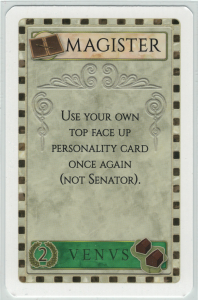
- Magister – In Individual Play, execute the action of the last card you played. In other words, the Magister works like a Senator, but on your own card instead of another player’s.
- Praetor – In Team Play, the Praetor replaces the Senator, which can only be used in Individual Play. The Praetor allows you to buy one card from the display, paying the cost shown on the card and any additional cost depicted below it. Then your partner gets to buy one card. Afterwards, the display is refilled.
- Proconsul – In Team Play, the Proconsul replaces the Consul. It works like a Consul, allowing you to purchase a single card without paying the extra cost listed below the card. Your partner then selects a card, other than Legatus, from her hand to play and execute. She alone takes that action.
- Legatus – Used only in Team Play, the Legatus lets you request that your partner play a particular card immediately. To make the request, you’ll silently look through your partner’s hand of cards. Choose the one you want her to play and place it on top. Your partner is then free to choose whether to play the card you requested or something else. Whichever card your partner chooses to play, your partner executes its action first, then you execute that card’s action.
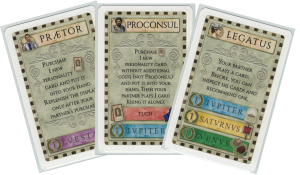
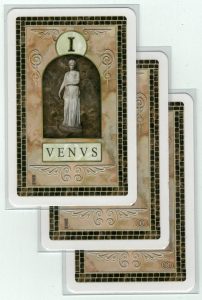
The publishers added some iconography to the back of the personality cards, so you can easily determine which cards to use in each type of game: a column indicates Individual Play, two linked circles Team Play.
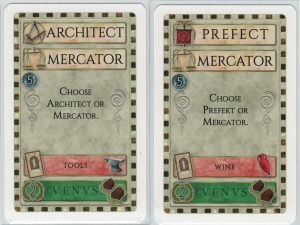
There’s also a new pantheon for game-end scoring in Concordia Venus: Venus herself. Featuring a dark green bar across the bottom, each Venus card features two personalities. For example, Architect and Mercator. In Team Play, the player playing the card, gets to choose one personality to execute, then his partner executes the other. In Individual Play, you can freely choose which personality to execute whenever you play the card. If another player Senators your card, she also chooses which option to execute. Likewise, should you play the new Magister card on the turn after you play a double personality Venus card, you can execute either personality.
What’s Different
As in the original Concordia, game end is triggered either when the last personality card is purchased or a player builds his last house. Concordia Venus game end scoring works the same as in the original Concordia with two exceptions:
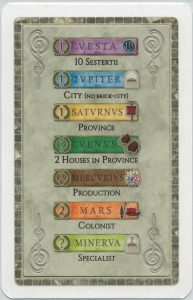
- There’s a new pantheon to be scored: Venus. In Individual Play, you score one point for each province in which you have built at least two houses times the number of Venus cards you have. In Team Play, you score one point for each province in which both you and your partner have built a house, times the number of Venus cards you have. Your partner does the same.
- Each Legatus card depicts three different pantheons: Jupiter (non-brick cities), Saturnus (provinces) and Venus (provinces with both you and your partner’s houses). Legatus counts once for pantheon.
In Team Play, scores are calculated for each player individually, then combined to determine each team’s score. Highest VP wins.
My Thoughts
Thus far, I’ve played a few games of Concordia Venus in Individual Play mode on the new maps and two 6-player Team Play games. Every game was really fun! I particularly enjoyed the double personality Venus cards.
In the Individual games, we all built a lot of houses. I found that I didn’t get into as many provinces as I would’ve like to because I was concentrating on building two houses in each province. I don’t remember regular Concordia games ending with someone building their last house that often. Usually, they end when someone buys the last card. I noticed that more of the Concordia Venus games I played Individually, ended with a player building her last house.
I must say that I really like the new Magister card. It’s sooo nice to be able to repeat the card you last played. I think most of the time I played the Magister so I could execute the other personality on a Venus card. For instance, the first play I Mercatored, then the next turn I played Magister to Architect. Very cool.
I adore the new Team Play mechanics in Concordia Venus! Both Team games I played were a total blast! However, they were also quite long. We did have a full complement of six players, though. In the first Team Play game, we had three veteran Concordia players and three newbies, so we arranged each team to have one of each. We allowed some table talk, so the veterans could suggest options to the newbies when they were stuck. It worked quite well. The second Team Play game I played, also a six-player game, was with seasoned Concordia players. It ran almost as long as the first game. It makes sense that it would run longer because each time you play, you do something, then your partner does something. It’s really, really important to use the orange current player marker in Team Play to keep track of who’s turn it is.
The new maps are exciting. The number of connections on the Ionium map are almost overwhelming – especially in a six-player Team Play game. With so many houses and colonists on the board, it can be hard to see all the connections. The designer moved the card display off the map to a separate board to provide more map space. Ionium is big! For a smaller player count of 2 to 3 players, you can place the card display on top of the left side of the map, just inside the scoring border. In other words, you can reduce the map size to provide more player interaction.
I think Concordia Venus is a great stand-alone and expansion. It is compatible with Salsa and all the map expansions out so far. I can’t wait to play it again – especially the Team game!
Concordia Venus supports 2 to 6 players, ages 12 and up and plays in 1 to 2 hours.
Copyright © 2020 by Tina G. McDuffie. All rights reserved.
Photo rights retained by their respective copyright holders.
